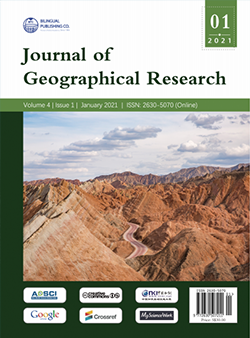-
1440
-
370
-
306
-
222
-
190
Pollution Aspects Interconnections to Socio-economical impact of Natuf Springs-Palestine
DOI:
https://doi.org/10.30564/jgr.v4i1.2686Abstract
This study aims at determining the types of pollutants and their sources for the springs in the Natuf catchment/Palestine in addition to evaluating the socio-economic environmental impact on water utilization from residential people. Twelve spring water samples were collected for hydrochemical qualitative analyses of major and trace elements as well as microbiological analyses in the summer of 2017. Plotted spring water samples on the Piper Diagram indicated the water type of Mg-Ca-HCO3- and eleven samples could be classified as fresh water. Fifty questionnaires were distributed to the farmers and land owners in order to study the impact of socio-economic and environmental conditions for the spring water utilization. The study shows that 90% of local people are using the springs for agricultural purposes. The spring water chemical analysis indicates that they are free from industrial pollutants in regards that 84% of them are located away from the dumping sites. The study shows that respondents are not interested in rain water harvesting during winter season, because 44% of them have their own cisterns. The existence of the water network as well as the absence of the related authority role's contributes to the reduction of people’s dependence on spring water. The results will be used for the qualitative aspects potentiality of the appropriated rainwater harvesting techniques to be installed in the area. It is recommended to establish a qualitative monitoring network in Natuf watershed as well as for the springs of the other catchments in the west Bank.
Keywords:
Pollution aspects; Hydrochemistry; Socio-economy; Natuf catchmentReferences
[1] United Nations. Report of the United Nations water conference. United Nations Publications, New 123 York, Mar del Plara, 1977.
[2] J. Chen, H. Qian, Y. Gao. Assessing Nitrate and Fluoride Contaminants in Drinking Water and Their Health Risk of Rural Residents Living in a Semiarid Region of Northwest China. Expo Health, 2017, 183-32, 195.DOI: https://doi.org/10.1007/s12403-016-0231-9
[3] Ameur, M., Hamzaoui– Azaza, F., Gueddari, M. Nitrate contamination of Sminja aquifer groundwater Zaghouan, northeast Tunisia: WQI and GIS assessments, Desalination and Water Treatment, 2016, 13.DOI: http://dx.doi.org/10.1080/19443994.2015.1137495
[4] Fallah-Mehdipour E., Bozorg-Haddad O., Loáiciga, H., Climate-environment-water: integrated and non-integrated approaches to reservoir operation.Environmental Monitoring and Assessment, 2020,192:60. https://doi.org/10.1007/s10661-019-8039-2
[5] Ghouili N., Hamzaoui-Azaza F., Zammouri M.,Zaghrarni M., Horriche F., de Melo, M.roundwater quality assessment of the Takelsa phreatic aquifer (Northeastern Tunisia) using geochemical and statistical methods: implications for aquifer management and end-users. Environ Sci Pollut Res, 2018, 25,36306–36327. Environmental Science and Pollution Research.DOI:https://doi.org/10.1007/s11356-018-3473-1
[6] Akib- Jabed M., Paul A., Nath, T. Peoples’ Perception of the Water Salinity Impacts on Human Health:A Case Study in South-Eastern Coastal Region of Bangladesh. Expo Health, 2020, 12, 41-50.DOI: https://doi.org/10.1007/s12403-018-0283-0
[7] Abed A., Wishahi S. Geology of Palestine: the West Bank and Gaza Strip. Palestinian Hydrology Group:Jerusalem, Palestine, 1999.
[8] Ghanem M. Hydrochemistry of the Natuf drainage basin in Ramallah area / West Bank. Journal of Environmental Geology, 2008, 55(2):359-367.
[9] Shalash I., Ghanem M. Hydrochemistry of the Natuf drainage basin in Ramalla area/West Bank.Journal of Environmental Geology. 2007, 1-6 .
[10] Ahmed W. The pollution effects of the wastewater flow on the water quality in Wadi Sarida catchment /West Bank. Master thesis. Birzeit University. Palestine, 2015.
[11] Bader B. The effect of cesspits on water springs pollution of Natuv catchment area-West of Ramallah.Master thesis. Birzeit University. Palestine, 2011.
[12] Daoud A., Hussein R., Matani M, Swaileh K. Quality assessment of roof-harvested rainwater in the West Bank, Palestinian Authority. Journal of Water and Health, 2011:525-533.
[13] Palestinian Water Authority PWA. Good and Health Water for all report. Ramallah-Palestine,2009.
[14] Todd D. Groundwater hydrology. Wiley, New York,1980.
[15] Ghanem M., Jebreen H., Sege J., Rubin Y. Impacts of Spring Water Quality Using a Web-Based on the Environmental Management System of Western Ramallah / Palestine. Euro-Mediterranean Journal for Environmental Integration.(Springer), 2019, 4: 2.DOI:https://doi.org/10.1007/s41207-018-0091-8
Downloads
How to Cite
Issue
Article Type
License
Copyright © 2021 Marwan Ghaleb Ghanem

This is an open access article under the Creative Commons Attribution-NonCommercial 4.0 International (CC BY-NC 4.0) License.




 Anwar Atta
Anwar Atta





